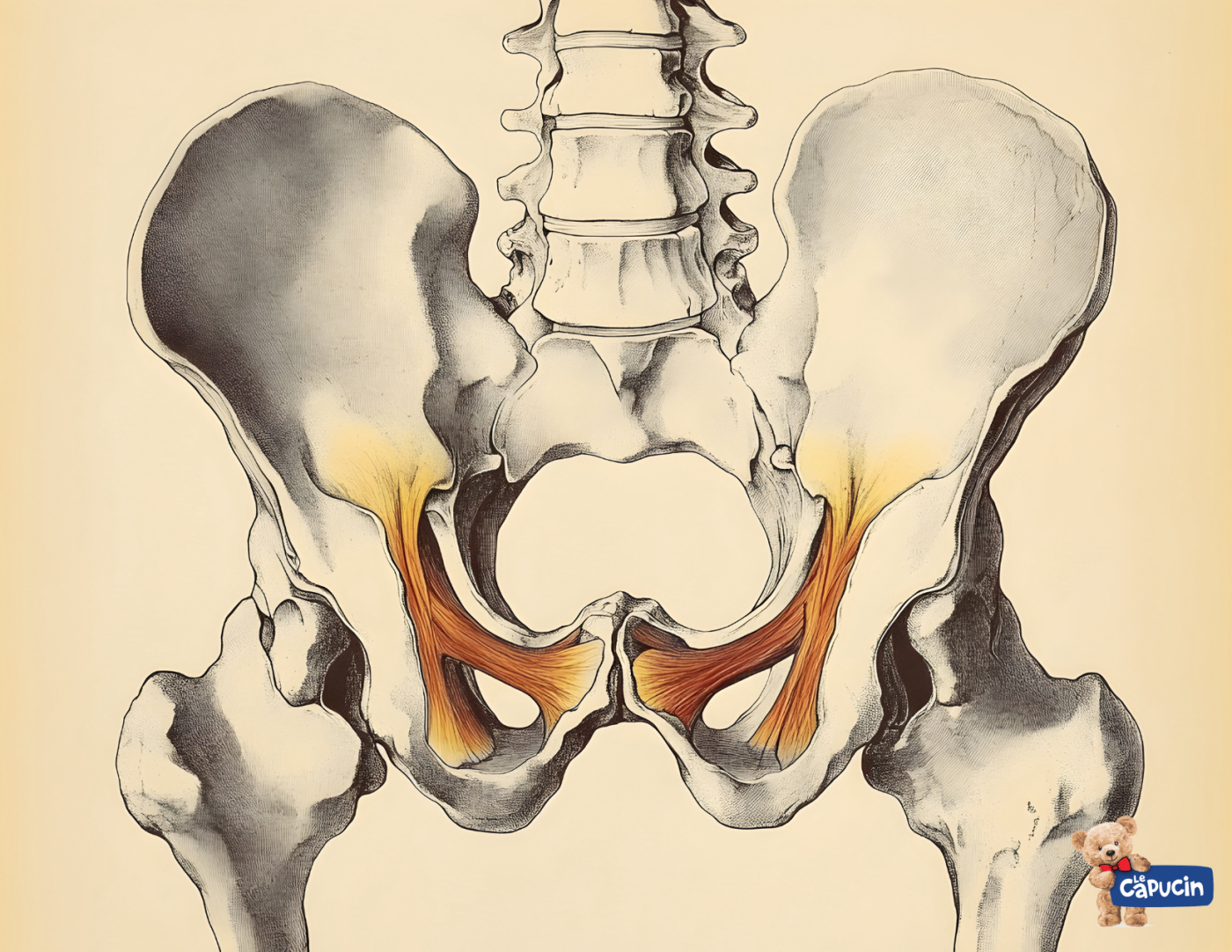Pubic Symphysis Pain During Pregnancy

Among the common discomforts during pregnancy is pain in the pubic symphysis. This issue raises many questions, so we’ve collaborated with our partner, Marie-Ève Prince, a perineal rehabilitation physiotherapist and owner of the Cigonia clinic, to address it.
You might not have been aware of this part of your anatomy until experiencing pain there. Before diving into tips to help you, let’s understand what the pubic symphysis is and how to alleviate and reduce the pain.
What is the Pubic Symphysis?
The pubic symphysis is the joint connecting the two coxal bones, or iliac bones, at the front of the pelvis. It’s located above the genital organs, in front of the bladder. This small joint consists of ligaments and cartilaginous tissues.
During pregnancy, these ligaments soften and relax under the influence of hormones like progesterone and relaxin. This increases movement in several joints, especially the pelvic ones.
This movement facilitates the opening of the pelvis, easing the baby’s passage during childbirth. The opening of the pubic symphysis is entirely normal and desirable during pregnancy. However, this phenomenon can cause discomfort.
Symptoms of Pubic Symphysis Pain
When pain is felt in this area, it’s usually due to irritation of the joint walls. Shearing movements of the iliac wings occur during asymmetrical movements, like walking, amplifying this irritation and causing pain.
Pain can appear in any of the three trimesters of pregnancy. Generally, it ceases after childbirth, but some women may feel it for several months postpartum.
Signs and Symptoms Include:
- Groin pain
- Pain in the pubic symphysis
- Sensation of the pelvis opening
- Radiating pain to the adductor muscles
- Difficulty opening the legs
- Pain and difficulty walking
- Pain when getting out of the car
- Pain during position changes
- Heaviness in the lower abdomen
Risk Factors Associated with Pubic Symphysis
Several factors or predispositions in pregnant women can be linked to pubic symphysis issues, including:
- Hypermobility or pronounced lumbar curvature (scoliosis)
- Intense physical exercise during pregnancy
- Fatigue
- Poor posture
- A baby heavier than average
- Multiparity (having had at least one previous childbirth)
- History of difficult childbirth
- Lack of exercise
How to Relieve and Prevent Pubic Symphysis Pain
Here are four tips to relieve and prevent pubic symphysis pain:
1) Avoid Asymmetrical Movements
For some women, simply walking can become a real ordeal. The normal asymmetrical movement of the legs during walking can irritate the joint. Get in the habit of exiting the car with both legs together. Do the same when getting out of bed. Avoid crossing your legs if the pain is significant. Some sports, like cross-country skiing or running, can be very painful. Opt for swimming or strength training exercises where your legs remain more static.
2) Adjust Your Sleeping Position
To avoid asymmetrical leg positions, sleep with a pillow or maternity cushion between your thighs. This promotes better pelvic alignment and relieves the pubic symphysis joint.
3) Strengthen Core Muscles
Performing pelvic floor exercises and transverse abdominal muscle workouts can be very helpful. Stabilizing your core improves posture, helping your body better support the baby’s weight. Remember to contract these muscles when walking or exercising to limit joint mobility.
4) Support the Abdomen
As the baby’s weight increases pressure on your pelvis, abdominal support can enhance comfort. In mild cases, pants with a support band can suffice. If that’s not enough, consider using Physiomat belts, which fall into the category of proprioceptive belts. They don’t support the muscles directly but activate them more. The principle is that the muscle works better with the belt in place because it’s more easily recruited. You can also consult a therapist who can apply adhesive tapes (taping) as needed. These tapes support your muscular system to reduce pressure on the joint.
Consult a Specialized Therapist
Don’t hesitate to consult a therapist during this period. Whether it’s an osteopath, chiropractor, acupuncturist, or physiotherapist, they can all assist you in their own way.
In cases of pubic symphysis pain, treatment involves loosening the muscles of the pelvic region and ligament attachments on the pubic ramus. It also aims to restore mobility to the sacrum and pubic symphysis joint. Strengthening and stretching exercises will also be recommended to complement the treatment.
Can Naturopathy Help with Pubic Symphysis Pain?
The answer is yes! Here are some tips for you:
Ensure you consume sufficient daily nutrients for your structural system: calcium, vitamin D, and magnesium. These three nutrients are typically included in a good prenatal vitamin.
Consume quality proteins and bone broths rich in collagen to support joint health.
Maintain efficient digestion and a balanced system by consuming chlorophyll and probiotics.
Booking an Appointment is Easy!
A consultation with your naturopath is highly recommended to support you according to your unique needs.
If you know moms facing similar challenges, feel free to share the information below!
Don’t hesitate to reach out or leave a comment if you have stories or tips to share that could help other moms!
Marie-Ève Prince
Marie-Ève Prince, Pht, Physiothérapeute en rééducation périnéale et propriétaire de la clinique Cigonia. Elle est aussi chargée de cours et conférencière à l’Université de Sherbrooke et à l’Université de Montréal.
Sa bio
Diplômée de l’Université de Montréal en physiothérapie, Marie-Ève Prince est titulaire d’une formation en rééducation périnéale. Fondatrice, directrice et propriétaire du Centre d’expertise Cigonia depuis sa création en 2002, Marie-Ève Prince met son leadership au service de cette profession en cumulant les mérites et en proposant des traitements innovateurs année après année.
Étant à la tête de la clinique regroupant le plus de physiothérapeutes en rééducation périnéale au Canada, cette pionnière dirige fièrement une équipe composée de près de vingt professionnels experts. Ses nombreux certificats issus de formations continues, dont certains sont issus de prestigieuses écoles américaines, lui permettent d’offrir différentes approches de traitement pour les problématiques urologiques, gynécologiques, ano-rectales et sexologiques.
Marie-Ève Prince est chargée de cours et conférencière au programme de maîtrise en physiothérapie et au doctorat en médecine à l’Université de Sherbrooke ainsi qu’à l’Université de Montréal au microprogramme en rééducation périnéale. Responsable de l’enseignement standardisé au doctorat en médecine pour le volet gynécologique, Marie-Ève Prince s’implique également auprès de plusieurs projets de recherche au Centre de recherche clinique du CHUS. Promouvoir l’importance de cette profession, travailler de pair avec les équipes médicales, offrir des solutions de première ligne et être un chef de file dans ce domaine, telle est sa mission!






Leave a Reply